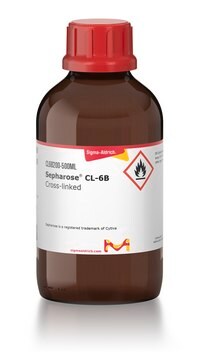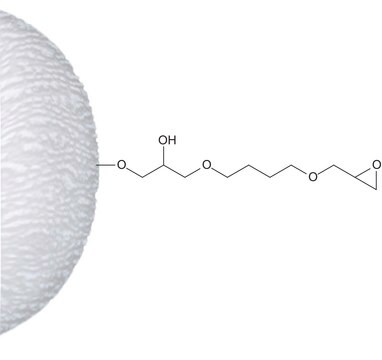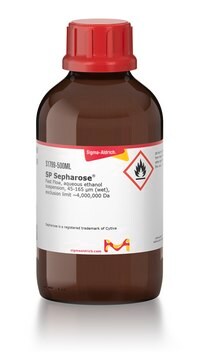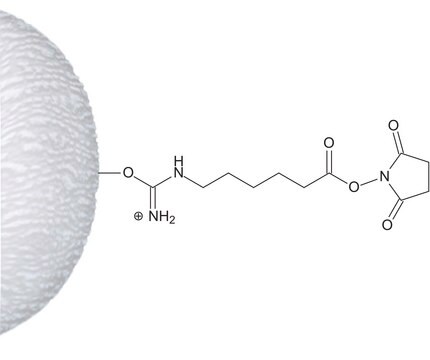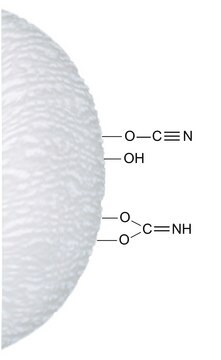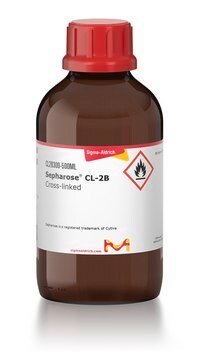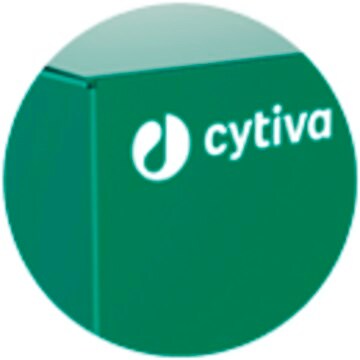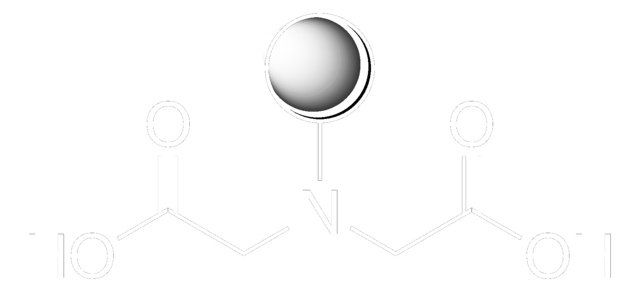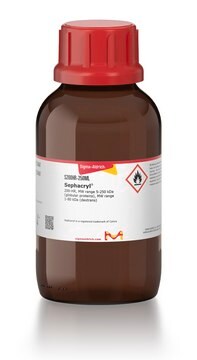Kluczowe dokumenty
6B100
Sepharose™ 6B
6% Beaded Agarose, 45-165 μm (wet), fractionation range 10,000-1,000,000 Da (dextrans)
Synonim(y):
Agarose, Beaded
About This Item
Polecane produkty
pochodzenie biologiczne
algae (marine)
Formularz
suspension
metody
affinity chromatography: suitable
Matryca
6% agarose
wielkość cząstki
45-165 μm (wet)
wielkość porów
10,000-1,000,000 Da fractionation range (dextrans)
10,000-4,000,000 Da fractionation range (globular proteins)
pH
4—9
temp. przechowywania
2-8°C
ciąg SMILES
OC[C@H]1O[C@@H](O[C@@H]2[C@@H]3CO[C@H]2[C@H](O)[C@@H](O3)O[C@H]4[C@@H](O)[C@@H](CO)O[C@@H](O[C@@H]5[C@@H]6CO[C@H]5[C@H](O)[C@H](O)O6)[C@@H]4O)[C@H](O)[C@@H](O)[C@H]1O
InChI
1S/C24H38O19/c25-1-5-9(27)11(29)12(30)22(38-5)41-17-8-4-36-20(17)15(33)24(40-8)43-18-10(28)6(2-26)39-23(14(18)32)42-16-7-3-35-19(16)13(31)21(34)37-7/h5-34H,1-4H2/t5-,6-,7+,8+,9+,10+,11+,12-,13+,14-,15+,16-,17-,18+,19+,20+,21-,22+,23+,24+/m1/s1
Klucz InChI
MJQHZNBUODTQTK-WKGBVCLCSA-N
Szukasz podobnych produktów? Odwiedź Przewodnik dotyczący porównywania produktów
Opis ogólny
Inne uwagi
Informacje prawne
zastąpiony przez
Hasło ostrzegawcze
Warning
Zwroty wskazujące rodzaj zagrożenia
Zwroty wskazujące środki ostrożności
Klasyfikacja zagrożeń
Flam. Liq. 3
Kod klasy składowania
3 - Flammable liquids
Klasa zagrożenia wodnego (WGK)
WGK 1
Temperatura zapłonu (°F)
100.4 - 109.4 °F
Temperatura zapłonu (°C)
38 - 43 °C
Wybierz jedną z najnowszych wersji:
Masz już ten produkt?
Dokumenty związane z niedawno zakupionymi produktami zostały zamieszczone w Bibliotece dokumentów.
Klienci oglądali również te produkty
Nasz zespół naukowców ma doświadczenie we wszystkich obszarach badań, w tym w naukach przyrodniczych, materiałoznawstwie, syntezie chemicznej, chromatografii, analityce i wielu innych dziedzinach.
Skontaktuj się z zespołem ds. pomocy technicznej

